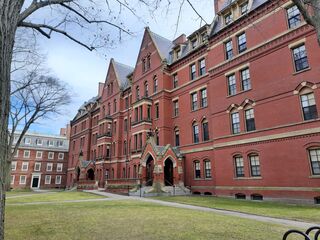Education
How Elite Colleges Divide Us and What We Can Do About It
The book, Poison Ivy, and the case for one percent solutions.
Posted October 5, 2022 Reviewed by Lybi Ma
Key points
- A new book argues that admissions policies of elite universities are a driver of residential and school segregation.
- The book argues for several policy changes that each would have an incremental impact, called one percent solutions.
- Many challenges in higher education, declining enrollments and equity gaps, may be best solved with one percent solutions.

“What elite colleges mainly do is keep a lot of rich people rich.”
In Poison Ivy: How Elite Colleges Divide Us,* CUNY Professor Evan Mandery lays out compelling evidence that Ivy League universities—along with peer institutions such as Stanford, MIT, Chicago, Duke, and Georgetown—propagate segregation and income inequality. Mandery argues that these colleges hoard opportunities in their massive endowments, student resources, and access to elite careers. In turn, he says, American parents hoard opportunities for their children by turning their communities and schools into mostly White enclaves, filled with college-application advantages such as AP courses, test prep centers, and club lacrosse teams (Mandery really has it out for lacrosse). Even if you believe this last sentence describes a wealthy, out-of-control minority, their behavior still affects the educational experience of every child in this country.
When Poison Ivy is released on October 25, you can decide for yourself whether you agree about elite universities doing more harm than good for our society. However, what I found most memorable is that Mandery ultimately argues not for sweeping reforms, but for incremental changes that collectively could close these opportunity and income gaps. In that way, I sensed a kindred spirit and fellow advocate for, as President Obama would say, “better is good.” And as a behavioral scientist, I wholeheartedly agree with Mandery that we should strive for more “one percent solutions.”
One percent solutions
“Zack Cooper, a health care economist at Yale…found that [an insurance company] could save $1 billion a year—about 1 percent of their spending—if they just had patients get [lower-limb MRIs] at the place closest to their home. After his speech, an executive complimented his speech, but said they wanted measures that would save them 15 percent, not 1 percent.”
Poison Ivy does not mention the terms “behavioral science,” “behavioral economics,” or “nudging.” But in Chapter 19, Mandery seems to choose sides in the debate about whether tweaks to how we communicate with people or construct their environments—interventions that often amount to one percent solutions—are worth our time, energy, and investment. For example, professors Nick Chater and George Loewenstein recently argued that nudge interventions have “led behavioral public policy astray,” distracting researchers from developing larger, systems-level reforms that could produce a 15 percent impact. In education, specifically, they warn: “There is the real danger that well-intentioned research providing a false hope of radical change from [nudging] interventions undermines public pressure for fundamental systemic change.”
Mandery explicitly rejects this all-or-nothing perspective. “If the standard is perfection, all is lost. But if the goal is to take lots of one percent steps, virtuous proposals abound.” For example, his recommendations for improving college admissions include:
- “Top class rank” policies, in which college admissions are based entirely on class rank (such as is done at the University of Texas at Austin)
- Elite colleges partnering with their local communities, school districts, and community colleges to bolster all educational opportunities in their area and create dedicated pathways into their hallowed halls (Mandery notes Clark’s example in Worcester, Massachusetts)
- Prioritizing admissions for working-class students in the same way elite colleges do for athletes, legacies, and early access applicants
If you’re focused more on retention and success once students do matriculate, this post has presented, in a way, a series of one percent solutions based on peer-reviewed, scientific evidence: Interventions such as growth mindsets, challenge mindsets, interdependent motives, self-affirmations, and social belonging. Although these “nudges” have been criticized at times for being insignificant, or distracting, or for not striking at the heart of what drives educational inequities, we know they produce meaningful effects (often many times larger than one percent.) If you’re looking for solutions that are inexpensive, easy to implement, and could add up to something truly transformative, I’d argue that "Nudging Ahead" is not a bad place to start.
Shooting for the moon
In 2015, the Robin Hood Foundation announced a $5 million prize “to find the most promising interventions that are capable of helping community college students with remedial needs—those at greatest risk of dropping out—continue their studies and attain their associate degree.” The benchmark that competitors had to surpass to earn the prize was a gain in CUNY students’ completion rates of (coincidentally) 15 percentage points. Over 6 years later, the experimental results from this initiative showed no impact on either of the two finalists.
I’m sure everyone involved in this prize—Robin Hood, ideas42, CUNY, and the finalists—had the best intentions and worked very hard to achieve that 15 percentage point gain. But after reading Poison Ivy, I found myself wondering whether the moonshot design itself was partly to blame for the program’s failure. Would the finalists have had a better chance of achieving some positive impact if the expectation and incentive for 15 percentage points weren’t there? Would CUNY have been better served had Robin Hood instead offered all 18 semifinalists $275,000 if they could each achieve a one-point gain? What Mandery highlights is that often our well-intentioned striving to find the solution blinds us to the several half-solutions right in front of us.
A call for one percent solutions
I call upon you to act as an agent of change. Fight within your residential and academic communities to soften borders and create opportunity. Change the narrative about merit. Inhabit the reality that neither affluence nor poverty is deserved.
I don’t mean to throw cold water on the whole idea of sweeping, systemic reforms. If we’re going to close equity gaps in education and income, we need big changes and I’m thankful for all of the people who think on that grand scale. But the last thing I love about one percent solutions is that they’re often achievable by any one of us. No matter your role, you can ask whether you can implement a change that will improve student outcomes by just one percent. And a good place to begin to look for some of those one percent solutions is in Poison Ivy.
*Full disclosure: I received an advanced copy of Poison Ivy to review. No other financial considerations have been made.




